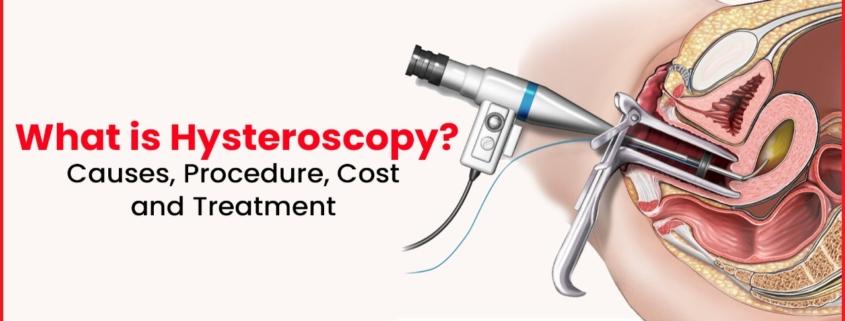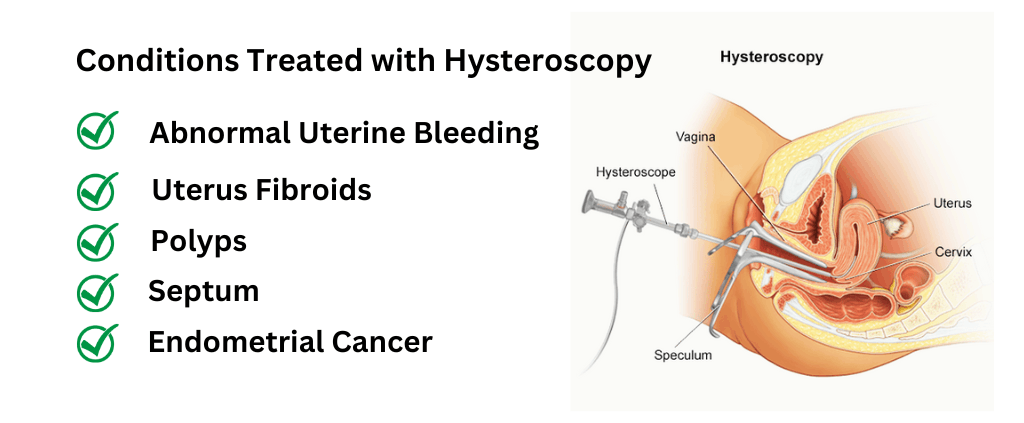Hysteroscopy: Purpose, Procedure, Cost & Treatment
Introduction to Hysteroscopy
What is Hysteroscopy?
Hysteroscopy is a procedure in which a hysteroscope (a flexible tube) is inserted through the vagina into the uterus. The hysteroscope has a light and camera at its tip, which allows doctors to see inside the uterus using transvaginal ultrasound or CT scans. The doctor uses this information to make sure there are no abnormalities that could affect fertility or pregnancy.
Indications for Hysteroscopy
The indications for hysteroscopy include abnormal cervical bleeding (menorrhagia), abnormal uterine size (polyhydramnios), fibroids, endometriosis, pelvic inflammatory disease, ectopic pregnancy, and pelvic pain secondary to pelvic inflammatory disease, and fibroids.
1. Endometriosis: to check for endometriosis, which is a condition wherein tissue resembling the uterus lining grows outside of it (also known as ectopic pregnancy), in other parts of your body like your ovaries, fallopian tubes, or elsewhere. It can cause infertility and pain during menstrual periods.
2. Painful Cycles: To assess for uterine fibroids, which are growths in or around the uterus that can cause pain during menses, heavy periods, or pelvic pain (dysmenorrhea). Uterine fibroids are noncancerous tumours that grow inside the uterus and may interfere with normal childbirth if left untreated.
Types of Hysteroscopy?

There are three types of hysteroscopy:
1) Unipolar Hysteroscopy – performed using a single cannula (a small tube inserted through the vagina and cervix)
2) Bipolar Hysteroscopy – performed using two cannulas (one in each cavity)
3) Three-dimensional Hysteroscopy – performed using three cannulas (one in each cavity)
Benefits of Hysteroscopy?

● Accurate Diagnosis: Hysteroscopy allows IVF doctors to directly visualize the uterus’s interior and look for any anomalies, like fibroids, polyps, adhesions, or uterine septum. It can help with accurate diagnosis and treatment planning.
● Minimally Invasive: With hysteroscopy, a minimally invasive procedure, you can leave the hospital the same day and return home. Compared to open surgery, it typically involves less discomfort, scarring, and recovery time.
● Potential Treatment: In addition to diagnosis, hysteroscopy can treat various conditions. For example, doctors can use specialized instruments to remove fibroids, polyps, or adhesions or to correct a uterine septum. It could improve fertility outcomes for women.
● Improved Fertility Outcomes: Hysteroscopy can improve fertility outcomes for women by identifying and treating any conditions that could interfere with embryo implantation or pregnancy. For example, removing a uterine septum or correcting an abnormality can increase the chances of a successful pregnancy.
Hysteroscopy Procedure
A hysteroscope, a tiny, lighted tube with a camera, is inserted through the cervix and vagina into the uterus during hysteroscopy, a minimally invasive procedure. The procedure may be performed in a doctor’s office or outpatient surgical centre and typically takes less than an hour to complete. Here is a breakdown of the hysteroscopy procedure:
1. Pre-procedure
Your physician will likely conduct a physical examination before the hysteroscopy and may request additional tests, like an ultrasound or blood work, to assess your condition. Additionally, you might be told to abstain from food and liquids for a certain amount of time before the procedure.
You will be required to change into a gown on the day of the procedure and lie on an exam table with your toes in stirrups. You may be provided with a sedative or anaesthesia to help you feel more at ease and unwind during the procedure.
2. Intra-procedure
Your doctor will perform a hysteroscopy, during which your cervix and vagina will be used to insert the hysteroscope into your uterus. Thanks to the camera on the hysteroscope, your doctor can see the interior of your uterus and spot any anomalies, like fibroids, polyps, or adhesions.
Depending on the procedure’s intended purpose, the physician may also use specialized tools to eliminate or treat any discrepancies found during the hysteroscopy. Since the procedure is outpatient, you can usually leave for home the same day.
3. Post-procedure
After the hysteroscopy, you will be watched in a recovery area until the anaesthesia wears off. After the procedure, you might experience brief mild cramping, spotting, or discharge.
Your doctor will likely give you detailed post-procedure care instructions, which may include refraining from sexual activity, using tampons, and engaging in strenuous workouts for a few days after the surgery. To ensure a quick recovery, you should also abide by any additional detailed instructions your IVF doctor may have given you.
Most women can undergo the procedure safely and effectively with proper pre-procedure preparation, intra-procedure monitoring, and post-procedure care.
Conditions Treated with Hysteroscopy
1. Abnormal Uterine Bleeding
Abnormal uterine bleeding refers to bleeding that is not part of a woman’s normal menstrual cycle. Numerous things, such as hormonal imbalances, fibroids, polyps, or cancer, can contribute to its development. The underlying cause of abnormal uterine bleeding can be determined and treated using hysteroscopy.
2. Uterus Fibroids
Noncancerous growths called uterine fibroids form in the uterus. They may result in symptoms such as pelvic pain, heavy or protracted menstrual bleeding, and others. The removal of tiny uterine fibroids can be accomplished through hysteroscopy.
3. Polyps
Growths that appear in the uterine lining are known as uterine polyps. They may result in abnormal uterine bleeding, pelvic pain, and other symptoms. Polyps in the uterus can be removed using hysteroscopy.
4. Adhesions
Asherman’s syndrome and uterine adhesions are scar tissue inside the uterus. Previous surgeries, infections, or other factors can cause them. Adhesions can cause infertility, recurrent miscarriages, and other problems. Hysteroscopy can be used to remove adhesions and restore normal uterine function.
5. Septum
A uterine septum is a wall of tissue that divides the uterus into two separate cavities. It can cause infertility, recurrent miscarriages, and other problems. Hysteroscopy can be used to remove the septum and restore normal uterine function.
6. Endometrial Cancer
One type of cancer that appears in the uterine lining is endometrial cancer. Endometrial tissue can be examined using hysteroscopy to detect endometrial cancer. If cancer is detected, hysteroscopy can remove the cancerous tissue.
7. Infertility Investigations
Hysteroscopy can be part of an infertility investigation to identify any structural abnormalities in the uterus contributing to infertility. For example, hysteroscopy can identify and remove polyps or fibroids that may prevent a fertilized egg from implanting in the uterus.
Hysteroscopy Cost
The cost of a hysteroscopy procedure can vary depending on several factors, the place, the kind of facility, and the length of the procedure, for example. However, the cost of hysteroscopy in Srinagar is around 25 000 – 30 000 INR. It includes the cumulative costs of pre-procedure, inter-procedure, and post-procedure expenses. Generally, the hysteroscopy procedure, where only diagnosis is involved, is much cheaper than the procedure where a surgical procedure is followed.
Post-Treatment Care and Recovery
After a hysteroscopy, you may experience mild cramping, spotting, or discharge. For a few days following the procedure, your doctor might advise against using tampons, engaging in strenuous physical activity, or having sexual relations. To ensure a quick recovery, you should also abide by any additional detailed instructions your doctor may have given you.
Risks and Complications
There are some risks, as there are with any medical procedure. These may include:
- Infection
- Heavy bleeding
- Perforation of the uterus
- Reaction to anaesthesia
- Fluid overload
It is essential to comprehend the procedure’s risks and advantages, as with any medical procedure, and any queries or worries should be brought up with your doctor before the procedure. Reviewing these risks with your physician before starting the procedure and getting help if you develop any strange symptoms later on is crucial.
Conclusion
Hysteroscopy is a safe and effective procedure used to diagnose and treat various conditions of the uterus. Most women can recover quickly and resume normal activities with proper post-treatment care and monitoring. The risks and benefits of the procedure should be understood, as with any medical procedure, and any queries or worries should be brought up with your doctor before the procedure. Hysteroscopy is a flexible procedure that can be used to identify and manage several uterine conditions. If you have any signs of abnormal uterine bleeding, fibroids, polyps, or infertility, speak with your doctor.
Why Imprimis IVF for Hysteroscopy?
Imprimis IVF is a fertility clinic that provides advanced methods and technological advances to improve the chances of a healthy pregnancy. According to Imprimis IVF, hysteroscopy is a diagnostic and therapeutic tool offered to women struggling with infertility or other reproductive issues. It is used to look inside the uterus and find any issues that might prevent embryo implantation and potentially treat them. In vitro fertilization (IVF) and additional reproductive techniques are more successful thanks to Imprimis IVF’s cutting-edge techniques and technology. Imprimis IVF aims to provide a comprehensive approach to fertility treatment and raise their patients’ chances of having a healthy pregnancy.





